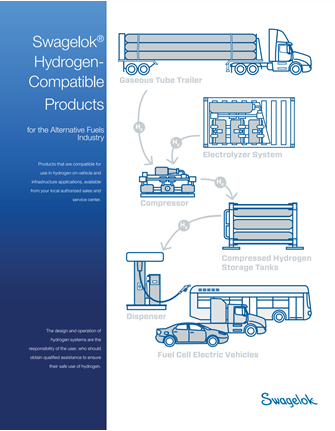Infrastructure for Hydrogen Applications
Did you know that Swagelok has products certified to EC-79 and HGV 3.1?Specific testing is required to achieve this certification, including corrosion resistance, endurance, hydraulic pressure cycle testing, and external leakage testing. Products with this certification will be specially marked to reflect the approval. |
What's the difference between EC-79 and HGV 3.1?
- EC-79 is used to comply to the regulations set by the European Parliament and of the Council for hydrogen powered vehicles.
- HGV 3.1 is used to comply to the regulations set by the The American National Standards Institute (ANSI) for hydrogen powered vehicles.
What's the difference between the H35 and H70 Classes?
- The H35 Class is for pressures above 30 bar (435 psig) and up to 350 bar (5,076 psig)
- The H70 Class is for pressures above 30 bar (435 psig) and up to 700 bar (10,159 psig)
Infrastructure applications include the dispensers, storage cylinders, compressors, separators, and pressure control devices that make up the station, as well as the hydrogen tube trailers that bring the hydrogen to the stations. Components in these locations must be hydrogen-compatible but may not require specific certifications. 
Hydrogen-compatible products are available for pressures up to 20,000 psig, that meets EC-79 for both pressure classes H35 and H70, such as:
- FK series medium-pressure fittings
- Swagelok tubing
- FKB series medium-pressure ball valves
- IPT series and check valves
- IPT series cone and thread fittings and tubing
- AFS series ball valves
- FJ, FL, FM, and FX series hose
- S model pressure gauges
- Pipe fittings
View Infrastructure Application Catalog
Where can Swagelok help you?
Aside from providing high quality fittings certified to EC-79 / HGV 3.1, we also offer a wide range of services to help you maintain and operate your fluid system safely, and efficiently. Our services include:
- Tool & Equipment Rentals
- Training in tube fitting installation and tube bending
- Sample Cylinder Maintenance
- Hose Advisory Services
- Compressed Gas Leak Detection
- Field Engineering
- Swagelok® Custom Solutions, such as filling, distribution, priority, and control panels and tubing manifolds.
Office of Energy Efficiency & Renewable Energy, article: Hydrogen: A Clean, Flexible Energy Carrier"Due to their high efficiency and zero-or near zero-emissions operation, hydrogen and fuel cells have the potential to reduce greenhouse gas emission in many applications. Energy Department-funded analysis has shown that hydrogen and fuel cells have the potential to achieve the following reductions in emissions:
|
